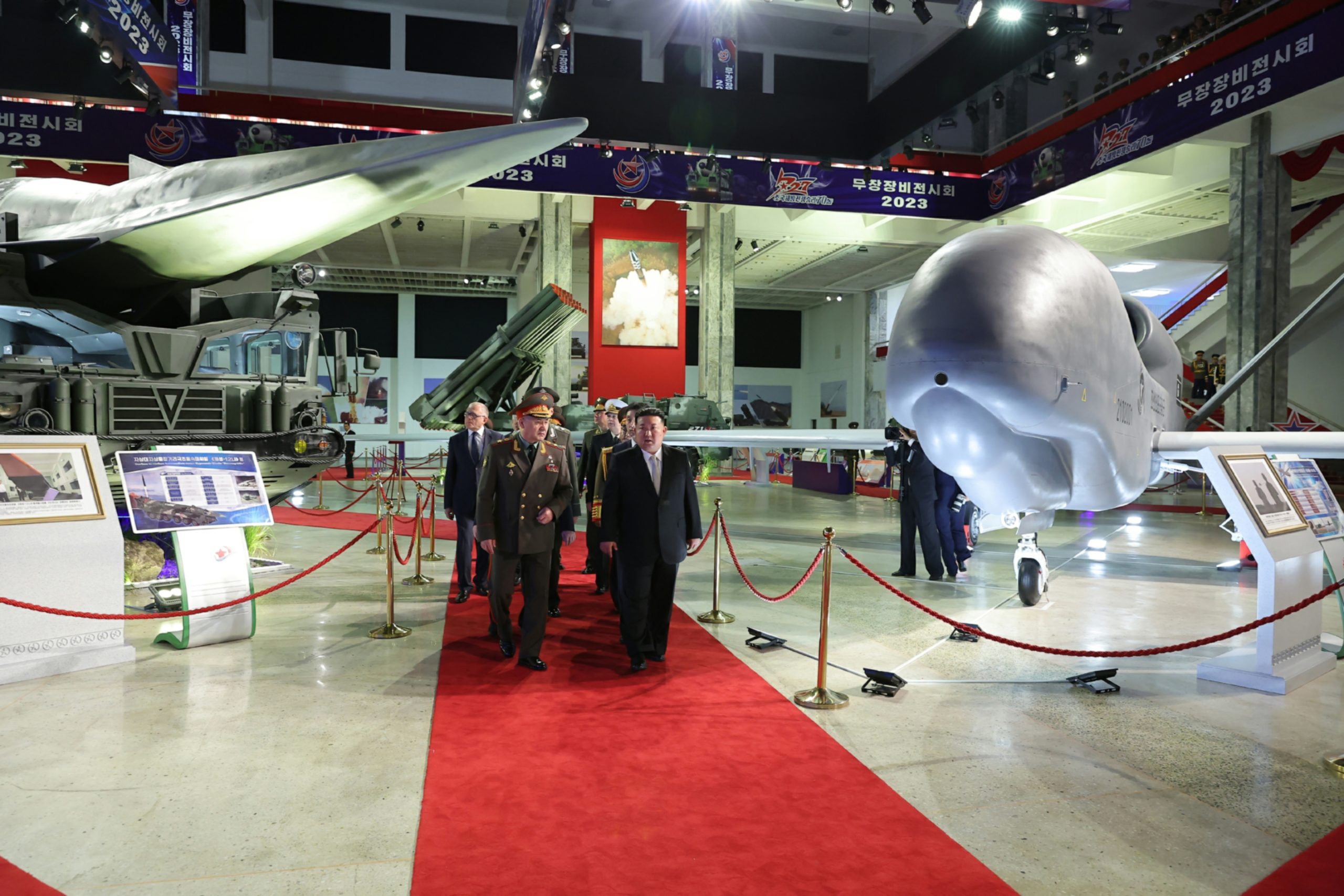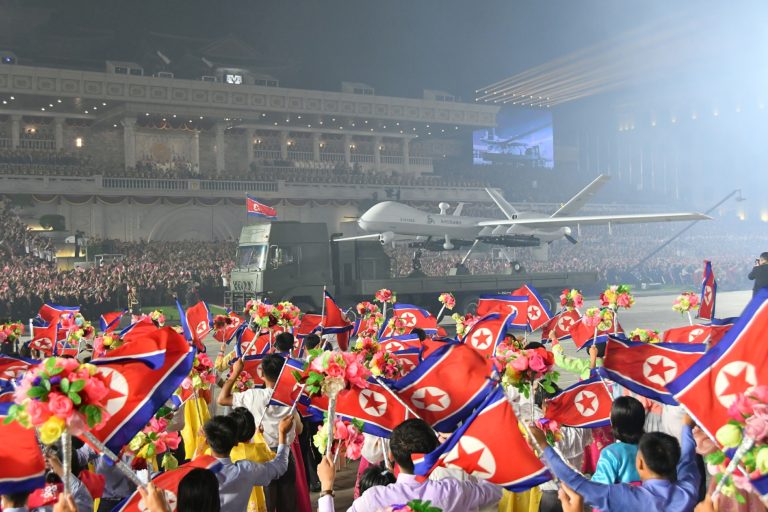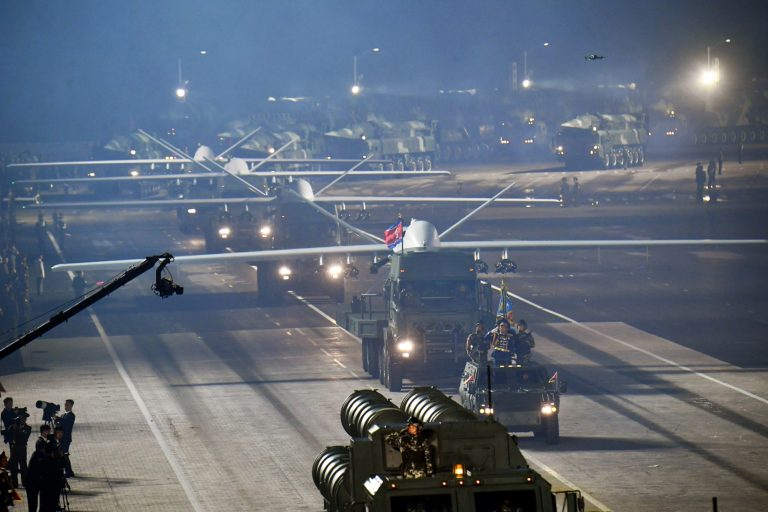Imitation Is the Sincerest Form: North Korea Unveils Two Types of Copycat UAVs
During an arms exhibition and military parade on July 26-27, North Korea revealed it is producing two new types of unmanned aerial vehicles (UAVs) that strongly resemble the large US Global Hawk and the medium-sized US Reaper. Pyongyang’s drone development was one of the many goals set during its Eighth Party Congress in 2021. It is not surprising that Pyongyang is able to develop these kinds of drones, given its success in developing missiles and producing light aircraft. However, while these new drones may look like US UAVs, the quality of the components hidden inside the airframes, which will determine their actual performance, is still unknown. These include: reconnaissance and targeting sensors, command and data links and engines.
There is broad agreement among outside analysts that the North’s new UAVs are highly unlikely to be as capable as those of the US. Nonetheless, Pyongyang clearly is trying to show its technological prowess by unveiling look-alike UAVs. Furthermore, even if they are less capable than their US counterparts, the two new types of UAV would provide North Korea with worthwhile new capabilities if deployed in sufficient numbers. This would allow the North enhanced intelligence collection capabilities, bolstering the assessment of “normal” allied military behavior and early warning of behaviors that might deviate from that norm. But the new drones will be more useful in peacetime than wartime, as they will be extremely vulnerable to US and South Korean fighter aircraft and air defenses.
Once its domestic requirements for the new UAVs have been fulfilled, Pyongyang is highly likely to offer the new systems for export. Although foreign demand for Reaper-like drones is likely to be strong, North Korea will face problems finding markets where its unproven products can compete with established UAV suppliers. One interesting possibility, however, would be export sales to Russia, especially in light of the shortcomings of Russia’s drone industry that have been revealed in the war with Ukraine.
Information to Date
On July 27, North Korean media reported on a visit the previous day by Kim Jong Un and Russian Defense Minister Sergei Shoigu to the “Weaponry Exhibition-2023” in Pyongyang. Associated photographs showed a medium-sized UAV resembling the US MQ-9 Reaper and a large UAV resembling the US RQ-4 Global Hawk. The Reaper-like UAV had air-to-surface missiles (ASMs) similar to the US Hellfire mounted under its wings and small bombs mounted under the fuselage.
North Korea held a military parade in Pyongyang on the evening of July 27 to celebrate the 70th anniversary of what the North calls Victory Day (the signing of the Korean War armistice), with Kim, Shoigu and Chinese National People’s Congress official Li Hongzhong in attendance. According to the press coverage, “the strategic reconnaissance drone and the multi-purpose attack drone which [were] newly developed and produced and [are] to be furnished for the KPA air force made circular flights.” Associated photographs showed four of the Reaper-like UAVs (presumably the “multi-purpose attack drone”) driven by on trucks while mounting the same munitions seen at the exhibition, and the Global Hawk-like UAV (“presumably the “strategic reconnaissance drone”) flying above the parade.
North Korean video released in conjunction with the parade showed both types of drones in flight and the Reaper-like drone firing ASMs while airborne. State television called the Global Hawk-like UAV the “’Saetbyol-4’ strategic reconnaissance drone” (Morning Star-4 or 샛별-4) and the Reaper-like UAV the “‘Saetbyol-9’ multi-purpose attack drone” (Morning Star-9 or 샛별-9).
Although the exhibition and parade were the first revelations of the new UAVs in North Korean media, the two UAVs had been identified previously in Western commercial imagery. The Reaper-like Saetbyol-9 was seen on September 4, 2022 imagery of Panghyon airbase, with a wingspan measuring some 20 meters (compared to 20.1 m for the US Reaper), and again on June 3, 2023 imagery. The Global Hawk-like Saetbyol-4 was seen on June 12, 2023 imagery of the same airbase, with a wingspan measuring some 35 meters (compared to 35.4 meters for the RQ-4A model Global Hawk).
In his report to the Eighth Party Congress in January 2021, Kim Jong Un referred to “the need to…conduct in real earnest the most important research to develop reconnaissance drones and other means of reconnaissance capable of precisely reconnoitring up to 500 km deep into the front”—presumably referring to the Global Hawk-like Saetbyol-4. Although Kim also referred in a different part of the report to how “the designing of various electronic weapons, unmanned striking equipment, means of reconnaissance and detection and military reconnaissance satellite were completed,” it is not clear whether he was referring to a strike UAV such as the Reaper-like Saetbyol-9. For example, at the time North Korea revealed the “Haeil” nuclear-armed unmanned underwater vehicle (UUV), the same phrase was cited as relating to the UUV.

On May 29, 2023, Ri Pyong Chol, vice chairman of the Central Military Commission of the Workers’ Party of Korea, noted that “the DPRK’s military reconnaissance satellite No. 1 to be launched in June and various reconnaissance means due to be newly tested are indispensable to tracking, monitoring, discriminating, controlling and coping with in advance in real time the dangerous military acts of the U.S. and its vassal forces….” It is unclear whether the “various reconnaissance means” referred to one or both of the new UAVs.
Implications
A political statement. North Korea clearly is trying to show its technological prowess to both domestic and international audiences by unveiling UAVs that look like top-flight US systems, a point it presumably tried to drive home by publically designating the Global Hawk-like UAV as Saetbyol-4 (to match the US RQ-4) and the Reaper like UAV as Saetbyol-9 (to match the US RQ-9). Demonstrating the fulfillment of another of the weapons development objectives of Kim Jong Un’s January 2021 Eighth Party Congress report likewise is politically important, underscoring the regime’s competence and capability and bolstering its prestige.
What counts is what’s inside. Given its success in developing ballistic and cruise missiles resembling foreign systems and producing light aircraft, it is not surprising that North Korea is able to produce UAVs resembling US models—particularly given the large amounts of publicly available information on the latter. But the real capability of the new North Korean UAVs is not apparent from the available information, as the determining factors are hidden inside their airframes: the types and quality of the reconnaissance and targeting sensors, command and data links and engines used. At the same time, there is broad agreement among outside analysts that whatever such components the Saetbyol-4 and -9 use, they are highly unlikely to be as capable as those in the US UAVs, given North Korea’s much lower level of electronics and aero-engine technology and the restrictions of Western export controls.[1]
Potential worthwhile addition. Even if less capable than their US counterparts, the two new types of UAV would provide North Korea with worthwhile new capabilities compared to its previous UAVs if they are produced and deployed in sufficient numbers: at least a dozen Global Hawk-like Satetbyol-4s and at least a few dozen Reaper-like Saetbyol-9s. We do not know how long it will take for the two drones to enter operational deployment (the North Korean press saying that they “are to be furnished” for the air force suggests deployment has yet to occur), their production rates, or their intended inventory sizes.
- The larger Saetbyol-4 could provide a high-altitude, long-loiter-time platform for reconnaissance sensors such as synthetic aperture radars and electronic intelligence receivers to see several hundred kilometers offshore and into South Korea from North Korean airspace, where the UAV could be commanded from the ground and relay the information it collects directly to ground stations within line of sight.
- The Saetbyol-9 could provide real-time tactical intelligence along the Demilitarized Zone (DMZ), help target other weapons systems such as artillery and short-range ballistic missiles and engage in limited strikes against discrete targets like buildings or vehicles within 10 km or so of the UAV using Hellfire-like ASMs.
To provide these capabilities beyond line-of-sight of North Korea, the UAVs ideally would use satellite communications (satcom). Although both new types incorporate the bulbous noses their US counterparts use to house satcom antennas, we do not know if they actually carry such antennas. Moreover, North Korea has no communications satellites of its own, although it may be able to lease bandwidth on Chinese or Russian satellites. Another possibility to extend the operating distance of the new UAVs would be to operate a chain of manned aircraft or other UAVs at intervals to act as communications relays, although this would add operational complexity and wartime vulnerability.
Given the recent rhetorical emphasis by both North and South Korea on being able to engage in preemptive strikes against each other, Pyongyang could find the prospect of regular, ongoing UAV intelligence collection in peacetime up to several hundred kilometers beyond the DMZ especially useful. This would allow the North to bolster its picture of what allied activity is “normal” and to obtain early indications of departures from “normal” that it might regard as preparations for an allied attack or an activity it might decide to “preempt.” Likewise, such information also could add to the picture North Korea might use to support first strikes of its own against the South.
But more useful in peacetime than wartime. Although US UAVs had free rein to operate over Iraq and Afghanistan, the presence of US and South Korean fighter aircraft and air defenses would make both new types of new North Korean UAV extremely vulnerable over allied airspace in both peacetime and wartime. This would even be true over North Korean airspace in wartime, given the size and sophistication of allied fighter forces and supporting capabilities relative to the North’s own air defenses.
Unlike the large numbers (hundreds to thousands) of small, low-altitude drones challenging air defenses in Ukraine, the Global Hawk-like Saetbyol-4 is the size of a Boeing 737 and must operate at high altitudes to collect strategic intelligence. Even the medium-size Saetbyol-9 would be quite visible on radar, needs to operate at altitudes susceptible to air defenses in order to obtain adequate visibility of its own targets, has poor evasive capability and will likely be deployed in relatively limited numbers.
Possible export product. Once its domestic requirements for the new UAVs have been fulfilled, Pyongyang is highly likely to offer the new systems for export. Although foreign demand for Reaper-like drones in particular is likely to be strong, North Korea will face problems finding markets where its unproven products can compete with established UAV suppliers. Even less savory customers are often able to obtain Reaper-like drones from China or Turkey. While there are fewer current potential suppliers of Global Hawk-like drones, there are also fewer customer countries likely to see the need for them. As with other conventional weapons, Pyongyang might try to compete on price, but it is unclear if it would be able to charge much less than other non-Western suppliers with established production lines or whether the Saetbyol-4 and -9 will be seen as sufficiently capable technologically to be worth what the North would charge for them. But one interesting possibility would be export sales to Russia, especially in light of the shortcomings of Russia’s drone industry revealed in the war with Ukraine, its purchase of Iranian drones (and drone production capability) and North Korean artillery ammunition for use in that war, and Defense Minister Shoigu’s participation in the July weapons exhibition and parade.
- [1]
For example, see Thomas Newdick and Tyler Rogoway, “North Korea Unveils Look-Alike Global Hawk, Reaper Drones,” The Drive, July 27, 2023, https://www.thedrive.com/the-war-zone/interpreting-north-koreas-look-alike-global-hawk-reaper-drones.


